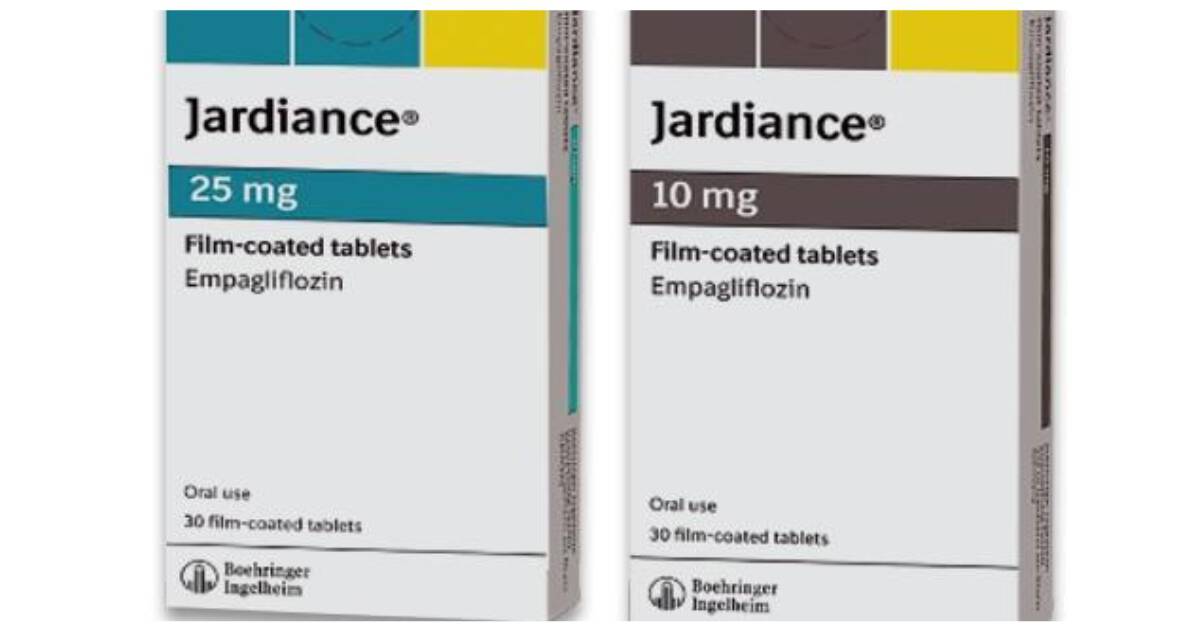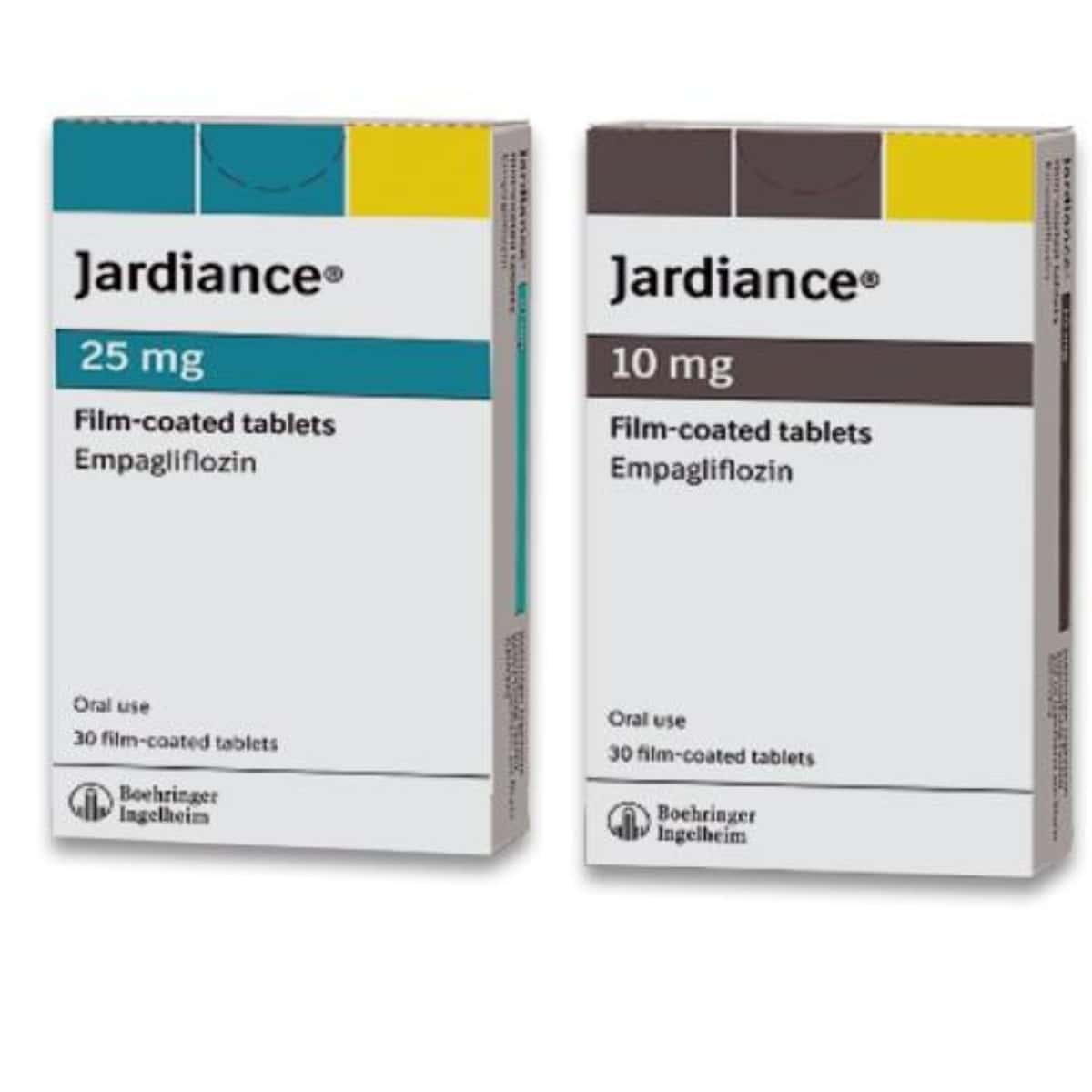[ad_1]
Jardiance is an oral prescription medication that helps treat the blood sugar levels in people with type 2 diabetes.
This article will explain everything you need to know about taking Jardiance.

What is Jardiance?
Jardiance is an oral medication that is available by prescription only.
The FDA has approved Jardiance as a treatment to help people with type 2 diabetes better manage their blood sugar levels.
Jardiance falls under the drug class of sodium-glucose cotransporter 2, also known as an SGLT-2 inhibitor medication.
These types of medications are commonly called gliflozins.
What are the benefits of Jardiance?
Jardiance has many benefits, including lowering blood sugar levels, improving heart health, and helping people lose excess weight.
Blood sugar control
In a 24-week study of adults with type 2 diabetes, a 10 mg dose of Jardiance helped 38% of people lower their A1C below 7%.
A 25 mg dose of Jardiance helped 39% of people lower their A1C below 7% (compared to just 13% of people taking the placebo.)
Jardiance also helped people lower their fasting blood sugar reading by up to 25 points (people taking the placebo actually had their fasting blood sugars increase during the study.)
Heart health
In a three-year study, Jardiance reduced the risk of cardiovascular death by 38% in people with type 2 diabetes and heart disease.
Jardiance lowers the risk of heart disease death and hospitalization for heart failure in adults living with heart failure.
Jardiance protects heart health when used alone or with metformin.
It works by lowering systolic blood pressure. This is excellent news for people with diabetes who struggle with high blood pressure and other cardiovascular issues.
Weight loss
Jardiance can help people lose weight.
In a trial, people taking 10 mg of Jardiance lost 2.5% of their body weight.
With the 25 mg dose, people lost an average of 2.8% of their total body weight.
Weight loss is not guaranteed, as it’s not FDA-approved as a standalone weight loss drug.
In a 2018 systematic review, Jardiance weight loss is usually small, but people can achieve between 3-5% total body weight reduction through continual treatment of between 9 months to 2 years.
Other studies have found that Jardiance use is associated with a reduction in weight, waist circumference, and adipose tissue versus people taking a placebo.
Weight loss success is supported by taking Jardiance, improving your diet, and increasing your daily physical activity levels.
Why would you be prescribed Jardiance?
People are usually prescribed Jardiance if they have type 2 diabetes and they’re having trouble managing their blood sugar levels.
Jardiance helps improve insulin sensitivity, bringing down blood sugar and A1C levels.
It also may also cause modest weight loss in people.
Jardiance also lowers the risk of heart attack and stroke in people with type 2 diabetes and heart disease.
You may also be prescribed this medication if you have type 2 diabetes and:
- You have heart failure: Jardiance is approved to treat two of the most common kinds of heart failure, preventing hospitalizations for heart failure as well as lowering the risk of death related to heart disease.
- You have heart (cardiovascular) disease
- You have kidney disease: Jardiance can slow kidney problems from worsening and also lower the risk of heart-related death in people with chronic kidney disease.
- You may also be prescribed Jardiance and metformin if you have type 2 diabetes and are struggling with insulin resistance, stubborn high blood sugar levels, or weight gain.
Jardiance can be prescribed along with other medications like metformin, or it can be prescribed alone.
What are the side effects of Jardiance?
Jardiance, unfortunately, does cause adverse side effects in many people.
The following are common and mild side effects of Jardiance:
- Urinary tract infection (UTI)
- Genital yeast infection
- Frequent urination
- Excessive (amount) of urination
Jardiance may also cause rare but mild side effects, including:
- Upper respiratory infection (the common cold)
- Joint pain
- Nausea
- Allergic reaction
- Increased thirst
Finally, Jardiance may cause rare but serious side effects, including:
- Low blood pressure
- Kidney damage
- Diabetic ketoacidosis (DKA)
- High cholesterol (especially LDL)
- Low blood sugar, especially if you’re on insulin
- Serious genital infections, including necrotizing fasciitis of the perineum
- Dehydration
- Severe urinary tract infection (UTI)
- Kidney infection
- Severe allergic reaction
Most side effects of Jardiance go away after a few weeks on the medication once your body gets used to it.
Contact your doctor right away or call 911 if your symptoms do not go away if they get worse, or if you suspect you’re having an allergic reaction to the medication.
If you’re on insulin, know the signs and symptoms of low blood sugar, including:
- Dizziness
- Weakness
- Fatigue
- Shakiness
- Grogginess
- Looking pale
- Sweating
- Headache
- Rapid heart rate
- Anxiety
- Headache
- Nausea
- Hunger
What are the Jardiance doses?
Jardiance comes in two doses:
- Beginning and ongoing treatment: 10 mg tablet, taken once per day
- If you need more glucose control, ongoing treatment: 25 mg tablet, taken once per day
You can take Jardiance either with or without food.
Never take more medication than you’re prescribed during the same 24-hour period.
How much Jardiance should I take?
This can only be determined between you and your doctor. However, for beginning treatment, people are prescribed 10 mg, taken once per day.
People may stay on this dose for four weeks. If they’re not experiencing severely adverse side effects and they’re not achieving better blood sugar levels, their doctors may increase their dose to 25 mg, taken once per day.
However, many people do achieve normal blood sugar levels staying at 10 mg, taken once per day.
25 mg, taken once per day, is the maximum dose of Jardiance.
How do I take Jardiance?
Jardiance comes in pill or tablet form and is to be taken once per day. You can take it with water and with or without food.
Try to take your medication around the same time each day, and try not to skip a day.
Never chew, crush, or split the tablet. Never take two tablets within the same 24-hour period.
What happens if I take too much Jardiance?
Taking too much Jardiance within a 24-hour period can cause severe adverse side effects.
Most notably, this can lead to dangerously low blood sugar levels, especially if you’re also on insulin.
Low blood sugar levels, if left untreated, can be fatal.
Monitor for signs and symptoms of extremely low blood sugar.
Seek emergency medical attention immediately if you suspect that you’ve overdosed on Jardiance.
Can I miss a dose of Jardiance?
If you miss a dose of Jardiance, do not worry. Try to take your next dose as soon as possible.
However, never take two doses of Jardiance within a 24-hour period.
If you’re more than halfway through the day after forgetting to take your medication, it is okay to skip a day and just wait until tomorrow’s dose.
Missing one day of your medication will not cause you to have higher blood sugar levels or increased insulin resistance.
Missing a dose every now and then will not cause you to gain weight.
However, the medication is most effective when it is taken consistently, so try not to forget to take your medication regularly.
Who shouldn’t take Jardiance?
Do not take Jardiance if you haven’t been prescribed the medication.
Jardiance should not be used to treat type 1 diabetes.
Let your doctor know if you have existing kidney or liver problems, a history of infection of the vagina or penis, a history of urinary tract infections (UTI), or problems with urination.
You should also talk to your doctor if you are going to have surgery, have a history of pancreatitis, or struggle with binge drinking alcohol.
Do not use Jardiance if you are pregnant, planning on becoming pregnant, or are breastfeeding. These medications may harm your unborn baby.
Lastly, talk to your doctor about any allergies you have to medications and about any questions or concerns you may have about taking Jardiance.
How do I stop taking Jardiance?
Never stop taking any diabetes medication, including Jardiance, without first consulting your doctor.
Abruptly stopping treatment can lead to high blood sugar levels, insulin resistance, and weight gain.
In order to stop, your doctor will likely want to taper your dose.
If you’re taking 25 mg, they may bring you down to 10 mg for several weeks.
If you’re taking 10 mg daily, your doctor may opt that you take the medication every other day, so stopping treatment is not a total shock to your system.
Additionally, your doctor may suggest alternative medications that may meet your lifestyle and health goals better, such as metformin, Rybelsus, Farxiga, or Invokana.
Does Jardiance replace insulin?
No, Jardiance does not replace insulin. If you’ve been prescribed insulin to manage your diabetes, you will need to continue to do so unless your doctor has advised you differently.
Jardiance can be used in conjunction with insulin if you’re not able to meet your blood sugar goals with Jardiance or insulin alone.
Can I take Jardiance with metformin?
Yes! Taking Jardiance and metformin at the same time is safe and effective.
There are even combination pills that mix the two medications together: Synjardy and Synjardy XR.
Synjardy is taken twice daily with meals.
Synjardy XR is taken once per day with your morning meal, usually breakfast.
This can make it easier to remember to take both medications and more convenient for you.
However, if you prefer to take these medications separately, you may.
How do I store Jardiance?
Keep all tablets in the original bottle for storing, away from sun exposure.
Store at 77°F (excursions between 59°- 86°F are clinically safe).
Keep Jardiance in a dry place, away from moisture. Never freeze or refrigerate Jardiance.
How can I get a prescription for Jardiance?
Connect with your doctor if you have type 2 diabetes and you’re struggling with insulin resistance or high blood sugar. They may recommend a prescription for Jardiance.
If you have type 2 diabetes and live with heart failure, heart disease, or kidney disease, talk with your doctor about your treatment options—including adding Jardiance to your treatment therapy.
[ad_2]
Source_link

